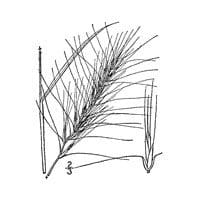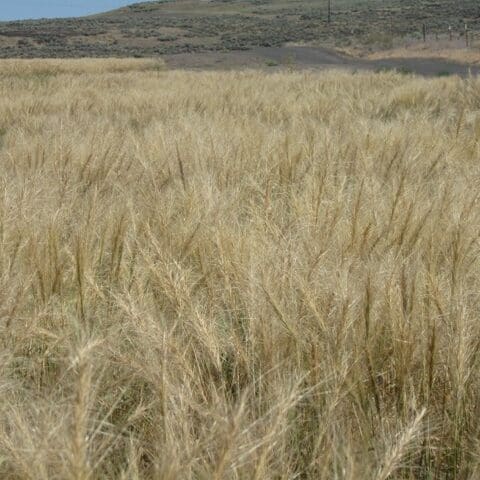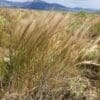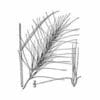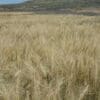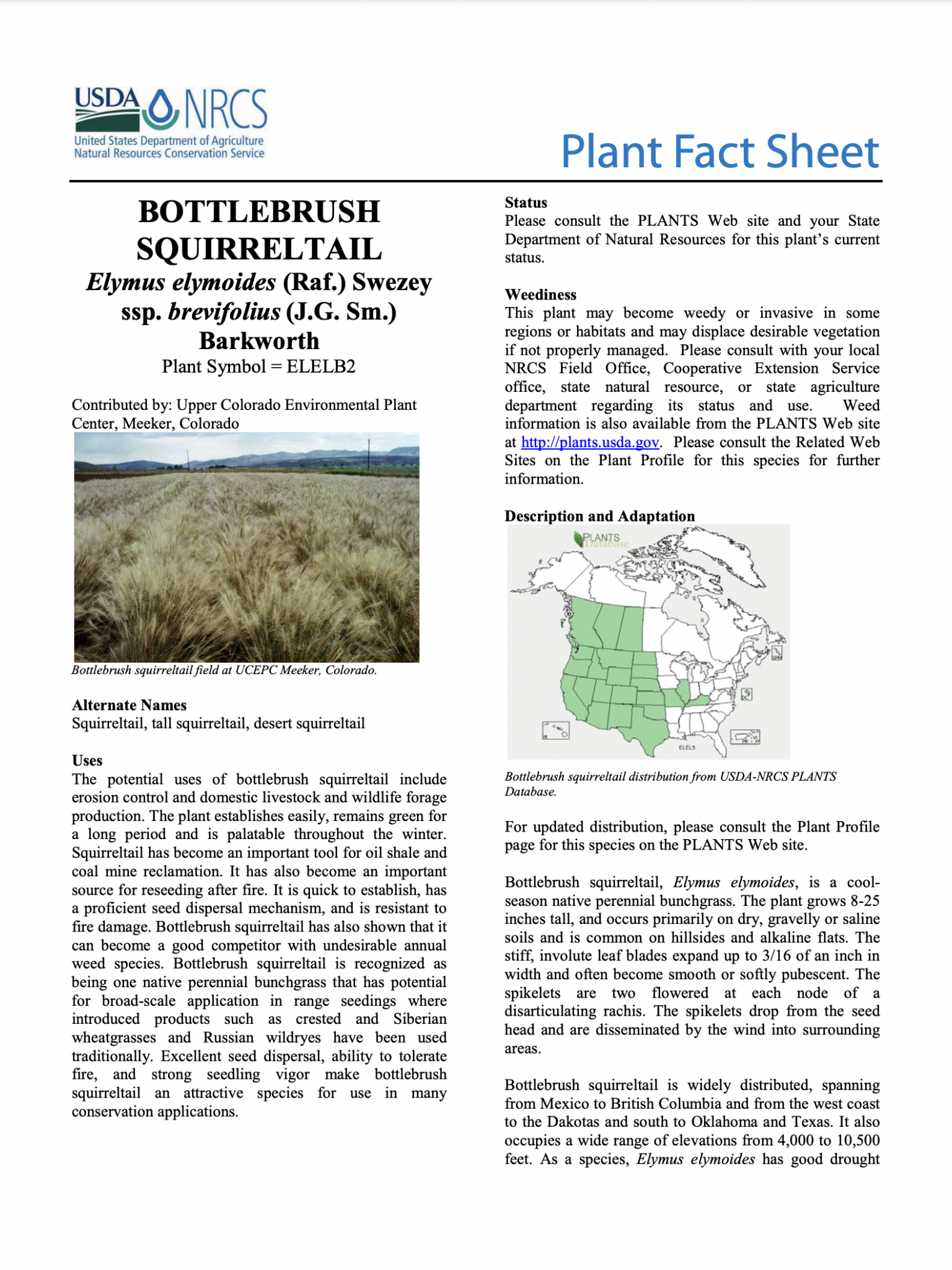Bottlebrush Squirreltail
- Scientific Name: Elymus elymoides
- Used extensively for erosion control and reclamation
- Very effective at controlling wind and water erosion
- Adapted to a wide range of ecological conditions
- Competes with and annual weedy species following fire
- One of the most fire resistant native bunchgrasses
Min. to Max. Annual Precipitation
24in.
Average Max. Height
Bright green perennial with bristly head that resembles a squirrel tail. Widely distributed but grows in scattered stands. Used extensively for erosion control and reclamation. When in large, dense stands, squirreltail is very effective at controlling wind and water erosion, due to its persistent ground cover.
Bottlebrush Squirreltail (Elymus elymoides) can be found throughout western North America from Canada to Mexico. It grows in a wide range of habitats, from shadscale communities to alpine tundra. Squirreltail is adapted to a wide range of ecological and topographical conditions. Plants can be found from 2,000 to 11,500 feet elevation, in desert shrub to alpine plant communities. Squirreltail grows well in medium to fine-textured soils, but also commonly occupies coarse-textured to gravelly soils. It tolerates low to moderately saline to alkaline run-in
Bottlebrush Squirreltail (Elymus elymoides) is a short-lived perennial grass which can compete with and replace annual weedy species following fire. It is thought that after squirreltail establishes, annual weedy species should decrease in frequency and longer-lived, native perennials may be more successfully reseeded and established. Its ability to germinate in the late fall and very early spring at a wide range of temperatures add to its capability to compete with cheatgrass (Bromus tectorum L.). Studies also indicate that squirreltail is capable of establishing in medusahead infested sites. This makes squirreltail one of the more competitive native grasses available for reseeding disturbed rangelands. It is also a self-fertilizing species which allows it to produce seed despite sparse stands following seeding.
Squirreltail (Elymus elymoides) is a short-lived perennial grass which can compete with and replace annual weedy species following fire. It is thought that after squirreltail establishes, annual weedy species should decrease in frequency and longer-lived, native perennials may be more successfully reseeded and established. Its ability to germinate in the late fall and very early spring at a wide range of temperatures add to its capability to compete with cheatgrass (Bromus tectorum L.).
Squirreltail is fair to desirable forage for cattle, horses and sheep in spring before seed head development and late summer to fall after seed shatter. The long, sharp awns of the florets and glumes can be injurious to grazing animals during mid to late spring into summer. Leaves green up in very early spring and are palatable through the fall, especially following rain. The tendency for some leaves to remain green through the winter makes squirreltail an important, though not especially nutritious, winter forage species. Table 1 shows crude protein levels for the spring, summer and winter.
For best results, bottlebrush squirreltail seed should be planted to a depth of ¼ to ½ inch into a firm weed-free seedbed. For pure stands the recommended drill seeding rate is 7 lb PLS per acre. Seed can be planted in early spring, but late dormant fall seeding is recommended for best annual weed suppression. Squirreltail does not establish well into existing perennial shrub communities without pre-mechanical treatment to reduce shrub density.
Plants that green up early will remain green through the fall and into winter. Stands should be protected from heavy grazing by livestock and wildlife, especially during flowering. Protection ensures sufficient seed production to maintain the stand. Wildland seed collection occurs from early July to mid September. Seed yields can vary widely depending on stand age and density. Because bottlebrush squirreltail seed is dispersed quite easily by wind, open fallow fields may be subject to bottlebrush squirreltail invasion.
***Click on the “Quick Plant Facts” tab above for more information.
Bottlebrush Squirreltail NRCS Plant Fact Sheet
Bottlebrush Squirreltail NRCS Plant Fact Sheet
PDF version of NRCS Plant Guide & Fact Sheet
Prepared By: Heather R Plumb, Plant Scientist-Range Plants (UCEPC) Meeker, Colorado.
Helpful Links
Additional information about this product can be found on the academic websites linked below.
Synonyms
Many plants have more than one common and scientific name. We've listed a few of them below.
- Bottlebrush Squirreltail
- Elymus elymoides
- Sitanion hystrix
Who is Great Basin Seed?
Great Basin Seed is a seed company that specializes in seed sales and consultation for home, ranch, farm, range and reclamation. We have been a leader in the seed industry since 1974.
Our History
We've been in the seed business since 1974.
What We Offer
We offer seed for home, farm, ranch, range and reclamation projects.
Meet the Gang
We have the best employees in the world! We are proud of the work they do, and trust them to serve you!
Right: Company founder Lloyd and his wife Paula Stevens in a wildflower seed production field circa 1977
Quick Plant Facts
| Common Name: | Bottlebrush Squirreltail |
|---|---|
| Scientific Name: | |
| Old Scientific Name: | |
| Lifespan: | |
| Origin: | |
| Plant Type: | |
| pH Tolerance: | |
| Seed Count | 192,000 seeds/lb. |
| Growth Height: | |
| Root Form | Bunchgrass |
| Sowing Rate | 7-12 PLS lbs. per Acre |
| Min. Precipitation | 5 – 6 Inches Minimum |
| Best Sowing Time | Fall or Spring |
| Max Sowing Depth: | |
| Growth Season: | |
| Sun & Shade Tolerance: | Full Sun, Shade Intolerant |
| Elevation of Occurance: | |
| Available Varieties: | |
| Hardiness Zones: |


